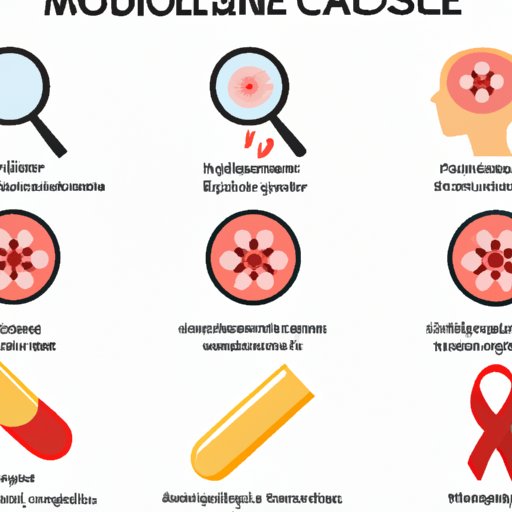
Introduction
Multiple myeloma is a cancer of the plasma cells, a type of white blood cell found in bone marrow. This disease is not as well-known as some other cancers, but it is still important to understand because it can be serious and potentially life-threatening. In this guide, we will explore what multiple myeloma is, how it develops, and what can be done to treat it.

Understanding the Basics of Multiple Myeloma
Multiple myeloma is a type of cancer that begins in the bone marrow and affects plasma cells. These are the cells responsible for producing antibodies that help the body fight infections. When plasma cells become cancerous, they begin to produce abnormal proteins that can cause damage to the body.
Multiple myeloma can develop slowly over time or it can progress rapidly. It is typically diagnosed when someone is in their mid-60s, but it can affect people of any age.
Who is at Risk of Developing Multiple Myeloma
Although the exact causes of multiple myeloma are not fully understood, some factors have been identified that can increase the risk of developing the disease. These include:
- Age
- Gender (men are slightly more likely to develop the disease than women)
- Family history of multiple myeloma
- Obesity
- Exposure to certain chemicals, such as benzene and pesticides
- Previous radiation or chemotherapy treatment
How Multiple Myeloma is Diagnosed
There are several tests that can be done to diagnose multiple myeloma. These include:
- Blood tests to check for abnormal proteins and other markers
- Bone marrow biopsy to examine the cells in the bone marrow
- Imaging tests, such as X-rays or MRIs, to look for bone damage or tumors
A Comprehensive Guide to Multiple Myeloma: Symptoms, Causes, and Treatments
Multiple myeloma can cause a range of symptoms, depending on how advanced the disease is. Some common symptoms include:
- Bone pain, especially in the ribs and back
- Weakness and fatigue
- Recurrent infections
- Nausea and vomiting
- Loss of appetite and weight loss
- Frequent urination and thirst
Possible Causes and Risk Factors
There is no one clear cause of multiple myeloma, but research has shown that certain factors can increase the risk of developing the disease. These include:
- Age
- Gender
- Family history of multiple myeloma
- Obesity
- Exposure to certain chemicals and radiation
Available Treatments for Multiple Myeloma
The treatment options for multiple myeloma depend on a number of factors, including the stage of the disease, the patient’s overall health, and their preferences. Some common treatment options include:
- Chemotherapy, which uses drugs to kill cancer cells
- Radiation therapy, which uses high-energy radiation to kill cancer cells
- Stem cell transplant, which involves replacing the patient’s bone marrow with healthy stem cells
- Immunotherapy, which stimulates the body’s immune system to fight cancer cells
Side Effects of Treatments and How to Manage Them
Like all cancer treatments, those used for multiple myeloma can cause side effects. These can include:
- Nausea and vomiting
- Fatigue
- Low blood counts
- Peripheral neuropathy
- Bladder irritation
It is important to talk to your healthcare provider about any side effects you experience during treatment. They can offer tips and medication to help manage them.
The Silent Killer: What You Need to Know About Multiple Myeloma
One of the most important things to know about multiple myeloma is that it can be a silent killer. In many cases, people with early-stage myeloma do not experience any symptoms. This is why it is important to get regular check-ups with your doctor and to undergo screenings to detect the disease early.
The Importance of Early Detection and Screening
Multiple myeloma is often detected during routine blood work or by chance if imaging tests are performed for other reasons. It is important to be proactive about your health and to talk to your healthcare provider if you have a family history of multiple myeloma or if you are experiencing any symptoms.
The Potential Complications of Untreated Multiple Myeloma
If left untreated, multiple myeloma can cause a range of complications, including:
- Bone pain and fractures
- Increased risk of infections
- Anemia
- Kidney damage
- Decreased mobility and quality of life
Strategies for Managing the Disease and Improving Quality of Life
Although multiple myeloma can be a serious and life-threatening disease, there are steps that patients can take to manage the disease and improve their quality of life. These include:
- Eating a healthy diet
- Getting regular exercise
- Managing stress
- Practicing good self-care
Delving Into the World of Multiple Myeloma: A Disease Overview
Multiple myeloma can be classified into different stages, based on the extent of the disease and other factors. These stages include:
- Smoldering myeloma, which is an early stage of the disease with no symptoms
- Active myeloma, which is when symptoms begin to appear
- Relapsed or refractory myeloma, which is when the disease comes back after treatment or does not respond to treatment
Understanding the different stages of multiple myeloma can help you work with your healthcare provider to develop an effective treatment plan.
How Multiple Myeloma Impacts the Body and Overall Health
Multiple myeloma can cause a range of physical symptoms, as well as emotional and psychological impacts. These can include:
- Chronic pain
- Depression and anxiety
- Decreased mobility and independence
- Increased risk of infection
Multiple Myeloma 101: An Introduction to the Disease for Patients
Being diagnosed with multiple myeloma can be overwhelming and confusing. This section provides an overview of the disease tailored specifically to patients and their families.
Multiple myeloma is a type of cancer that affects plasma cells in the bone marrow. It can cause a range of symptoms, including bone pain, fatigue, and recurrent infections. If you have been diagnosed with multiple myeloma, it is important to work with your healthcare team to develop a treatment plan that is right for you.
How to Work with Healthcare Providers and Caregivers to Manage the Disease
Managing multiple myeloma requires ongoing communication with healthcare providers and support from family members and caregivers. Some tips for working together to manage the disease include:
- Keeping a journal of symptoms and treatment effects to share with your healthcare provider
- Attending appointments with a list of questions to ask your healthcare provider
- Talking openly with family members and friends about your needs and feelings
- Accepting help from others when needed
Navigating the Complexities of Multiple Myeloma: A Guide for Caregivers
Caregiving for someone with multiple myeloma can be demanding and emotionally challenging. This section provides information and resources to help caregivers support their loved ones.
Information and Resources to Help Caregivers Support their Loved Ones with Multiple Myeloma
There are many resources available to caregivers of people with multiple myeloma. These can include:
- Support groups for caregivers
- In-home care programs
- Counseling services for caregivers and family members
- Financial assistance programs to help manage the costs of treatment and care
Tips for Managing the Emotional and Practical Challenges of Caregiving
Caregiving for someone with multiple myeloma can be challenging, both emotionally and practically. Some tips for managing these challenges include:
- Asking for help when needed
- Taking time for self-care and stress management
- Learning as much as you can about the disease and its treatment
- Talking openly with your loved one about their feelings and needs
Current Advances in Multiple Myeloma Research and Treatment
Research into multiple myeloma is ongoing, and new treatments and therapies are being developed all the time. Here are some promising areas of research:
- Immunotherapy, which stimulates the immune system to fight cancer cells
- Targeted therapies, which focus on specific proteins and pathways involved in the growth of cancer cells
- Precision medicine, which uses genetic testing and other tools to develop personalized treatment plans for patients
How Patients can Stay Engaged with Updates and Advances in the Field
Staying engaged with current advances in multiple myeloma research and treatment can help patients and their families feel more informed and empowered. Some ways to do this include:
- Attending conferences and seminars geared toward patients and caregivers
- Joining online patient communities to connect with others who have myeloma
- Reading up on the latest research from reputable sources
Conclusion
Multiple myeloma is a complex disease that can be challenging to navigate for both patients and caregivers. However, with early detection, effective treatment, and ongoing support, many people with myeloma are able to manage the disease and maintain a good quality of life. If you or someone you love has been diagnosed with multiple myeloma, know that there are resources and support available to help you through this journey.




